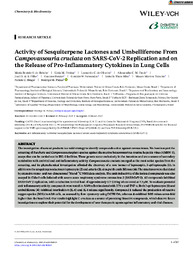Activity of Sesquiterpene Lactones and Umbelliferone From <i>Campovassouria cruciata</i> on SARS?CoV?2 Replication and on the Release of Pro?Inflammatory Cytokines in Lung Cells
Activity of Sesquiterpene Lactones and Umbelliferone From Campovassouria cruciata on SARS?CoV?2 Replication and on the Release of Pro?Inflammatory Cytokines in Lung Cells
Autoria: RABELO, M. B. de O.; FREITAS, K. M.; OLIVEIRA, L. C. de; FRADE, A. C. M.; S. FILHO, J. D. de; HEIDEN, G.; FERNANDES, G. W.; SILVA, I. T.; TEIXEIRA, M. M.; BRAGA, F. C.; PÁDUA, R. M.
Resumo: The investigation of natural products is a valid strategy to identify compounds active against coronaviruses. We herein report the screening of Baccharis and Campovassouria plant species against the murine betacoronavirus murine hepatitis virus-3 (MHV-3), assays that can be carried out in BSL-2 facilities. These genera occur exclusively in the Americas and are a source of secondary metabolites with antiviral and anti-inflammatory activity. Campovassouria cruciata emerged as the most active species from the screening, and its phytochemical investigation afforded the discovery of a new isomer of leptocarpin, 3-epi-leptocapin (1), in addition to the sesquiterpenes lactones leptocarpin (2) and arturin (3), along with umbelliferone (4). The structures were elucidated by extensive mono- and two-dimensional 1H and 13C NMR data analysis. The antiviral activity of the isolated compounds was also assayed in Calu-3 cells infected with severe acute respiratory syndrome coronavirus 2 (SARS-CoV-2). All compounds inhibited SARS-CoV-2 replication, with a reduction in viral load of approximately 1.7-2.0 log when tested at 7.5 µM. To evaluate potential anti-inflammatory activity, compounds were tested in A549 cells stimulated with IFN-? and TNF-?. Both 3-epi-leptocarpin (1) and umbelliferone (4) inhibited interleukin-6 (IL-6) and IL-8 release significantly. Compound 1 reduced the production of reactive oxygen species (ROS) in A549 cells, as assessed by flow cytometry using DCFH-DA, whereas 4 exhibited ROS values seven-fold higher than the basal level. Our results highlight C. cruciata as a source of promising bioactive compounds, which deserve future investigations to explore their potential for the development of new therapeutic agents against inflammatory and viral diseases.
Ano de publicação: 2025
Tipo de publicação: Artigo de periódico
Unidade: Embrapa Clima Temperado
Observações
1 - Por padrão são exibidas publicações dos últimos 20 anos. Para encontrar publicações mais antigas, configure o filtro ano de publicação, colocando o ano a partir do qual você deseja encontrar publicações. O filtro está na coluna da esquerda na busca acima.
2 - Para ler algumas publicações da Embrapa (apenas as que estão em formato ePub), é necessário ter, no celular ou computador, um desses softwares gratuitos. Sistemas Android: Google Play Livros; IOS: iBooks; Windows e Linux: software Calibre.
Acesse outras publicações
Acesse a Base de Dados da Pesquisa Agropecuária (BDPA) para consultar o acervo completo das bibliotecas da Embrapa.

